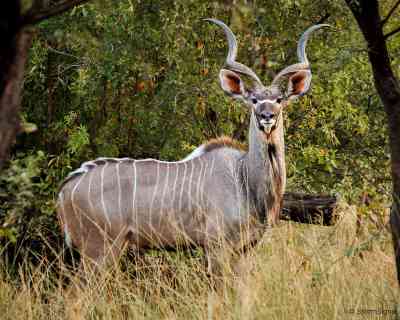Animals with horns in Africa are a fascinating sight, but they face a dire fate due to hunting. Many of these majestic creatures are hunted for their horns, leading to a decline in their populations. It is unfortunate that some species are even on the brink of extinction, purely because of their horns. Despite these challenges, there are still millions of animals with horns covering the savannas of Africa. From graceful herds of Bovidae to solitary rhinoceros, each species has its unique characteristics, and it is an awe-inspiring experience to witness them in action. Understanding these creatures and their significance is crucial in protecting them for future generations.
Table of Contents
Animals With Horns or Antlers?
The nuances of language have led to the use of the term “horns” to describe the head coverings worn by most African animals. In contrast, the term “antlers” is reserved for the structures found on the heads of many animals inhabiting North America, such as caribou.
Antlers specifically develop on animals belonging to the Cervidae family, which includes species like moose, elk, and deer. These growths usually feature a velvety texture during their initial stages, distinguishing them from the coarse keratin composition of horns. As time progresses, the velvet exterior disappears, leaving behind smooth and lustrous antlers.
Conversely, the category of “horns” pertains to animals within the Bovidae family. This encompasses diverse species of antelopes, and gazelles, as well as domesticated animals like cows, sheep, and goats. Horns are characterized by their rugged texture and composition. Similar to human nails, they maintain continuous growth throughout the animal’s lifespan, compensating for wear and tear due to various activities.
A fundamental distinction between horns and antlers can be immediately recognized: horns are solid structures, displaying variations in shape, curvature, and prominence, yet they remain a unified mass. On the other hand, antlers branch out into formations resembling fingers or branches, differentiating them from the singular composition of horns.
Discover African Animals With Horns
Gazelle
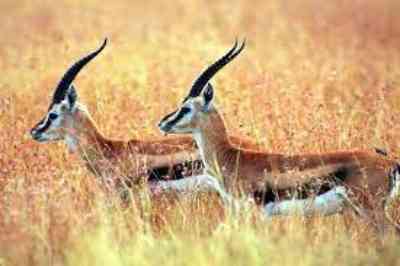
Gazelles, encompassing a diverse array, include more than 14 distinct types falling under the collective genus Gazella within the antelope category.
Within this grouping, six gazelle types are indigenous to Africa, among them the Dorcas gazelle, which thrives in the Sahara Desert and various Northern African regions.
Notably, the Grant’s gazelle stands out due to its considerable height. In contrast, the slender-horned gazelle finds itself endangered, a consequence of habitat loss and human expansion.
Further species of African gazelles encompass Speke’s gazelle, Thomson’s gazelle, and dama gazelle.
In the realm of African gazelles, both genders exhibit horns (although exceptions do exist). However, there is a trend where females tend to possess shorter horns than their male counterparts.
Male gazelles, equipped with longer horns, leverage this attribute to vie for dominance within their social hierarchies. The establishment of dominance involves challenging other males using their horns.
Beyond asserting dominance, horns serve an additional role in protecting the young gazelles, known as fawns. The possession of horns in males is believed to naturally attract females, primarily due to the essential role these horns play in safeguarding their offspring – a primal instinct at work.
Impala

The impala stands as one of the most prevalent antelope species across Africa. Renowned for their incredible swiftness, these creatures display leaps of astonishing magnitude, soaring up to 3 meters high and covering distances of up to 10 meters.
In the presence of danger, impalas serve as sentinels for their herd, issuing loud barking signals to alert their companions. During times of abundance in terms of food and water, they exhibit a tendency to form smaller groups.
Conversely, when the dry season ushers in scarcity, impalas congregate in vast gatherings, with group sizes swelling to encompass 100 to 200 individuals, collaboratively embarking on quests for sustenance and water.
A notable trait among impalas is the exclusive growth of horns in males. These horns, characterized by their dark hue, curve outwards from the impala’s head, leading to tips that are significantly separated. The distinctive curvature serves a purpose – facilitating male impalas in locking horns during confrontations over dominance. These horns, typically measuring around 70 cm in length and bearing ridges, possess the necessary strength to endure male combat. Despite their robustness, the horns maintain a hollow interior, featuring a circular cross-section.
Interestingly, female impalas exhibit an intriguing adaptation: they have the capacity to prolong their pregnancies by up to an entire month if they sense danger or if resources are scant, reflecting their remarkable ability to adapt to their environment.
Kudu

Among the substantial members of the Bovidae family, the greater kudu stands out, reaching towering heights of up to 150 centimeters.
Distinctively recognized by their grandeur, the males of this species, referred to as bulls, boast impressive horns. These horns are renowned for their exceptional length, with some of the longest ever recorded spanning a staggering 180 centimeters, solidifying the kudu’s distinction.
An evident disparity exists between male and female kudus due to the unique presence of horns exclusively among the bulls. This trait provides a straightforward means of distinguishing between the two genders, aided further by the females’ comparatively daintier and shorter stature.
The elegance and magnificence of kudu horns are undeniable. Their aesthetic allure makes them sought-after items in the market. Beyond mere decoration, these horns find purpose in various realms. Many African tribes ingeniously transform them into musical instruments, and they even double as containers due to their hollow composition. Furthermore, the horns play a pivotal role in traditional African ceremonies and rituals.
Kudu males utilize their splendid horns in duels for dominance against other males. The spiral structure of these horns facilitates easy interlocking, enhancing their efficacy in combat scenarios. This distinctive adaptation not only serves as a symbol of their strength but also highlights the elegance and functional versatility of these remarkable appendages.
Gemsbok
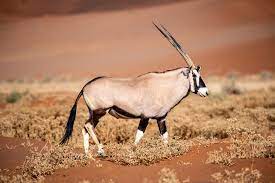
Gemsboks, also known as oryx, encompass two primary variations.
The southern gemsbok predominantly inhabits arid regions such as the Kalahari, while the northern gemsbok (oryx) roams the open grasslands, mainly in East Africa’s northern sectors.
These graceful antelopes exhibit sociable tendencies, often congregating in groups of around ten individuals. When resources like food and water become scarce, they adapt by forming smaller groups or even dispersing as solitary wanderers.
Despite their elegance, gemsboks possess a formidable side – they can be remarkably dangerous. Employing their horns, they execute a lethal charge by lowering their heads. This defense mechanism is so potent that it renders them less reliant on fleeing from predators.
The name “sabre antelope” is sometimes used to refer to the gemsbok, alluding to the deadly horn capable of impaling adversaries or potential threats. In practice, the horn tips are so sharp and perilous that numerous African tribes employ them as spearheads.
Both male and female gemsboks bear horns, although females possess notably slimmer horns compared to their male counterparts. These horns, extending remarkably straight forward, span an impressive length of 83 centimeters. This adaptation, along with their overall horn structure, reflects the gemsboks’ distinct blend of grace and potency.
Waterbuck
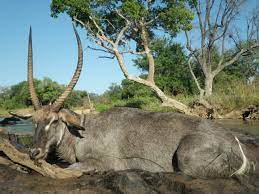
Two distinct species of waterbuck exist the defassa and the common waterbuck.
Waterbucks, despite their intriguing qualities, are notably among the most malodorous inhabitants of the African plains. Their shaggy brown coats exude an oily substance, seemingly for the purpose of waterproofing. However, this secretion carries an exceptionally strong and unpleasant odor.
These creatures inhabit a diverse range of landscapes, including woodlands, savanna grasslands, and regions proximate to stable water sources. Their close proximity to water sources typically ensures a consistent food supply, as they predominantly graze on hardy grasses that other animals tend to overlook.
The waterbuck’s horns are characterized by their elongated form and gentle curvature. Remarkably, these horns exhibit continual growth throughout the animal’s life, making the length of the horn a reliable indicator of the creature’s age. It’s noteworthy that only the male waterbucks possess horns, while the females remain without.
Male waterbucks utilize their horns for dual purposes: as a means of warding off predators and establishing dominance once they reach sexual maturity. When engaged in conflicts with other males, the confrontations can escalate dramatically. Often, these confrontations only conclude when one of the two combatants succumbs, highlighting the intense nature of these clashes.
Springbok
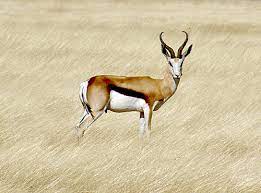
Springboks, comparatively smaller in size among African horned animals, exhibit intriguing behaviors. Female springboks tend to create their own herds, within which they nurture their offspring.
These herds usually include a select number of dominant males. Springboks derive their name from their remarkable leaps, which can reach heights of up to 3.5 meters. These leaps, scientifically known as “pronking,” are believed to serve the purpose of distracting potential predators.
Springboks are adaptable feeders, consuming a variety of plant types based on seasonal and environmental availability. They have a preference for plants and flowers with higher water content, although they readily graze on grasses as well.
A distinguishing trait of springboks lies in their horns. Both males and females possess horns, characterized by their modest dimensions of approximately 50 centimeters in length. These horns showcase an elegant black hue and curve in a backward direction. Additionally, the horns exhibit evenly spaced ridges spanning from the base to the tip, contributing to the overall aesthetic allure of these remarkable appendages.
Eland
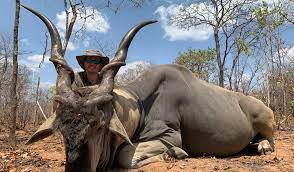
The eland, a member of the antelope family, stands as one of the slowest members within its ranks. Notably, it also holds the distinction of being one of the largest animals with horns across Africa. Elands can attain impressive lengths of up to 3 meters and carry weights of up to 900 kg.
In situations of extreme water scarcity, elands possess the remarkable ability to regulate their water metabolism by elevating their body temperature. This adaptation equips them to survive within the semi-arid terrains spanning from Southern Africa to regions as far-reaching as Ethiopia, Angola, and Malawi.
Within Africa, a trend has emerged wherein elands are chosen over cattle. Their enhanced resilience and capacity to withstand drought conditions make them preferable. Eland meat and milk are considered viable substitutes, further supporting this choice.
Eland horns may not be excessively lengthy or ostentatious, but they are perfectly adapted to serve their purpose. Both male and female elands grow horns, albeit with distinctions. Male horns are typically shorter and thicker, while female horns tend to be longer and thinner. These horns possess a twisting pattern near the base, followed by a curvature that results in a V shape. In terms of length, these horns usually extend to around 70 centimeters, showcasing an elegant and functional design.
Bongo
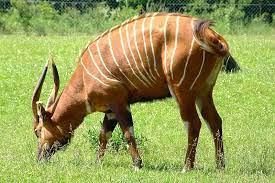
Bongos, captivating members of the antelope family, are linked to a belief in certain African cultures, where they are thought to induce seizures in humans. This superstition instills avoidance of bongos among individuals harboring these beliefs.
Among the larger antelopes, bongos encompass two distinct genera: the lowland (western) bongo and the mountain (eastern) bongo.
Possessing acute hearing, bongos can attain remarkable speeds of approximately 60 km/h when fleeing from predators.
Distinct social dynamics are observed among bongos. While males lead solitary lives, females congregate in groups, nurturing their young together. These groups, or herds, typically comprise 5 to 40 individuals, including offspring.
Bongo horns command attention with their exceptional dimensions, potentially extending up to a remarkable 99 centimeters in length. Both males and females feature a pair of twisted, lyre-shaped horns. Notably, the male horns often exhibit greater twists and girth, rendering them more visually striking.
Wildebeest
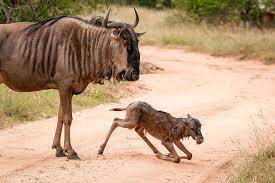
Wildebeests, instantly recognizable with their distinctive anvil-shaped heads, have evolved into symbolic figures often conjured when envisioning the African plains. They’ve earned the moniker “the poor man’s buffalo.”
A defining characteristic that sets them apart is the magnitude of their herds. During the migration period across East Africa, over 1 million of these creatures partake in the awe-inspiring phenomenon known as the great wildebeest migration, journeying toward fresh pastures as the rains arrive.
Two wildebeest species exist, with the blue wildebeest being the more commonly recognized. Despite its name, its back shimmers with a silver hue while its head is adorned in black. The black wildebeest, in contrast, is much darker overall, appearing black from a distance but revealing its true brown color upon closer inspection.
In the realm of wildebeest horns, both males and females boast horn growth, yet males exhibit significantly thicker and larger horns. Adult males can sport horns with an impressive width of around 50 centimeters. These horns play a pivotal role in male-female interactions, serving as tools for impressing females. This courtship endeavor involves bellowing and vigorous thrashing, contributing to a unique display that aids in territory establishment and mate attraction.
Cape buffalo
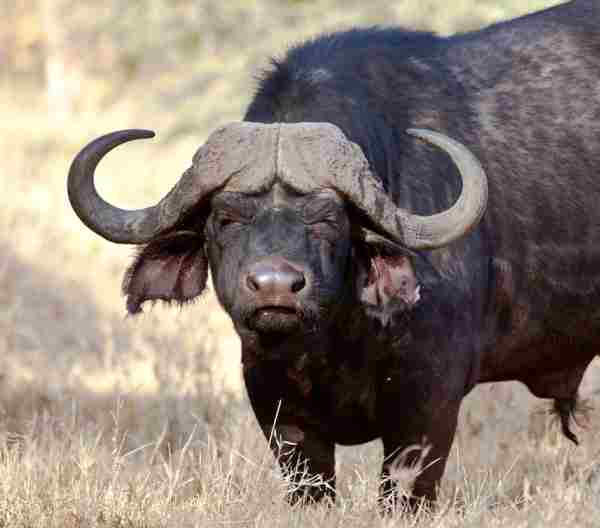
Referred to as the African buffalo, this colossal bovine inhabits the vast plains of Africa, favoring environments like swamplands and savannas.
Renowned as one of the most substantial and successful grazers, these animals play a pivotal ecological role.
The African buffalo encompasses four distinct subspecies, namely the African forest buffalo, the West African savanna buffalo, the central African savanna buffalo, and the southern savanna buffalo, also known as the Cape buffalo.
Among the remarkable characteristics of these creatures is their impressive size, with the largest individuals weighing around 910 kg, nearly equivalent to a ton. Their agility is equally noteworthy, as they can attain speeds of up to 56 km/h.
Central to the African buffalo’s visual identity are its prominent horns. These horns possess an ornate and decorative quality, adorning the top of the head before gracefully curving towards a sharp point. A defining aspect of buffalo horns is the fused base from which they emerge, growing as a natural extension of the animal’s bone. Both males and females exhibit horn growth, typically reaching lengths of around 80 cm, with variations that occasionally exceed this standard measurement. This striking horn formation contributes to the unique allure and distinctiveness of these magnificent creatures.
Hartebeest

The term “hartebeest” originates from the combination of the words “tough” and “ox,” a fitting description for these creatures. When observed from a distance, they bear a semblance of slightly misshaped antelopes.
Hartebeests exhibit robust family structures with well-defined hierarchies among the male members. Notably, male hartebeests might even sacrifice necessary hydration to maintain their alpha status within their territory. This decision stems from the common scenario of returning to find another male who has seized the alpha role.
Their breeding season is intricately tied to the presence of rain. If sufficient food and water are available, regardless of the season, hartebeests engage in breeding activities.
Turning to their horns, these features typically extend to around 50 centimeters in length. Their curvature manifests as a gradual outward and then inward trajectory, creating an elegant curve. Ridges also adorn these horns. Remarkably, both male and female hartebeests develop horns, with their length being an indicator of the animal’s age. These horns continue to grow throughout their entire lives, contributing to their unique appearance and characteristics.
Nubian ibex
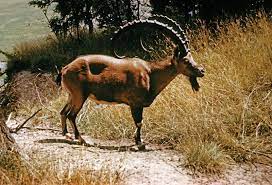
Resembling goats with remarkable horns, the Nubian ibex inhabits rocky outcrops in mountainous regions. They display a preference for social groups, with female groups comprising up to 8 individuals.
Conversely, males often venture alone. However, during the breeding season, they temporarily integrate into female herds for a span of up to eight weeks to facilitate mating. To secure this privilege, the males must first vie for dominance, a process in which their large, backward-curving horns play a crucial role.
The most noteworthy aspect of these animals with horns is the manner in which standoffs occur – often taking place at considerable heights, even on the precipices of cliffs or rocky formations. In these confrontations, Nubian ibex not only contend with each other, but also navigate the perilous terrain. A single misstep could result in a fatal fall, emphasizing the high stakes and risk involved in these contests for dominance.
Scimitar-horned oryx
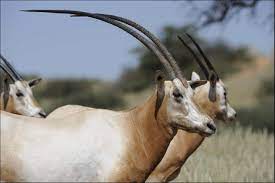
Also known as the Sahara oryx, this creature has faced extinction in the wild since the year 2000, primarily due to excessive hunting for their valuable horns. However, efforts have been made to reverse this trend through breeding programs in specialized reserves. Notably, Chad has achieved successful reintroduction of these animals into their natural habitat.
Endowed with remarkable adaptability, these oryxes possess the capability to survive with minimal water consumption, rendering them well-suited for arid environments such as deserts. Interestingly, they don’t adhere to traditional social structures like bachelor pods or female herds. Instead, they maintain groups of up to 70 members.
The defining feature of the scimitar-horned oryx lies in their horns. Both males and females exhibit long, straight horns that boast a distinctive backward curve. Female horns often display a more slender appearance. These horns contribute to their unique visual identity, measuring up to an impressive 1.2 meters in length.
Rhino
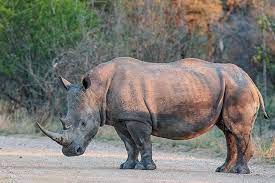
Rhinos stand among the most recognizable horned animals in Africa. The two main species, the black rhino and the white rhino, have achieved significant notoriety. Tragically, these creatures have been pushed to the brink of critically endangered status due to rampant poaching for their valuable horns.
The allure of rhino horns has led to their demand in certain cultural contexts. Despite ongoing efforts to curb poaching, the issue persists as a devastating threat to numerous African national parks and conservation initiatives.
Rhino horns are a defining aspect of these creatures. Both species, black and white rhinos, possess two horns, although they typically exhibit variations in shape and size. The black rhino’s horns are more evenly proportioned and possess a rounded base. On the other hand, white rhinos generally display one large horn and one smaller horn, along with a slightly more “squarish” shape.
These horns serve multiple purposes, including self-defense and aiding in finding food. White rhinos, being grazers, utilize their horns to locate and consume low-growing plant matter. In contrast, the black rhino’s browsing behavior leads it to feed on tree-based sources, including leaves, twigs, and fruits. The unique functions of these horns contribute to the distinct ecological roles that each rhino species fulfills in their respective habitats.
Giraffe

Giraffes stand out for their iconic long necks and uniquely patterned coats. Their ability to survive on a diet rich in water-dense plants enables them to drink water only every few days.
To process the rough and cellulose-rich plant matter they consume, giraffes possess four stomachs.
Upon birth, a giraffe calf can drop a significant distance to the ground from its mother’s height. Remarkably, within a mere day, the calf gains the strength to run alongside its mother.
Giraffes possess a distinct feature known as ossicones, which serve as their equivalent of horns. The precise purpose of ossicones remains a mystery, but giraffes do employ them for self-defense. A typical tactic involves the giraffe swinging its head and neck vigorously from side to side, utilizing the ossicones to fend off threats. Interestingly, not all giraffes possess two horns—some have three. Ossicones, though resembling antlers, are covered with skin and differ from traditional horns. They possess a texture akin to the giraffe’s legs: firm yet slightly fuzzy to the touch.
FAQs
Which African animals have horns?
African wildlife is known for its diversity and uniqueness, and many animals you come across are equipped with distinctive horns that define their look. Interestingly, horns are not just meant for defense, but they also play a crucial role in attracting mates and establishing dominance. Several animals with horns come to mind, such as the mighty rhinoceros, the light-footed antelope, the unmistakable water buffalo, and the majestic kudu. Each species has its brush with horns, and some even have multiple.
What has horns in Africa?
When we think of African wildlife, one of the first characteristics that come to mind are the magnificent horns that adorn many of the species living on this vast continent. From the towering spirals of the kudu to the sharp, corkscrew-shaped antlers of gazelles, there are a plethora of animals with horns in Africa. Did you know that even rhinoceroses, elephants, and buffalo sport these impressive features? Although the purpose of these horns can vary between species, they all serve to make African wildlife one of the most unique and awe-inspiring ecosystems on the planet.
What African animal has straight horns?
The scimitar-horned oryx, also known as the Sahara oryx, is an African animal that has straight horns.
Final Words
African animals with horns are some of the most iconic and recognizable creatures on the planet. These majestic animals can be found throughout the continent, from the savannas of Tanzania to the deserts of Namibia. With their majestic horns, these animals are not only an important part of the African ecosystem but also an essential aspect of African culture and folklore. Despite being awe-inspiring, their significance goes beyond just their appearance. From defending themselves to attracting mates, their horns serve a multitude of purposes. However, as majestic as they are, populations of these animals are at risk across the continent due to hunting and habitat loss.
Reference:
- https://safarinear.com/african-animals-with-horns/
- https://redrockscenicbyway.com/african-horned-animals/
- https://animals.sandiegozoo.org/animals/oryx

Zahra Makda
Growing up enjoying the beauty of my village, a good passion for nature developed in me from childhood. Following my passion for the natural world, I have chosen zoology for my graduation, during my undergraduate degree, I participated in many nature trails, bird watching, rescues, training for wildlife conservation, workshop, and seminars on biodiversity. I have a keen interest in invertebrate biology, herpetology, and ornithology. Primary interests include studies on taxonomy, ecology, habitat and behavior.

